Strategic Leadership, Decision Making, and Corporate Governance
VerifiedAdded on 2020/06/04
|10
|2628
|37
Report
AI Summary
This report provides a comprehensive analysis of strategic leadership and its crucial role in organizational performance. It begins by defining strategic decision-making as a process that involves creating organizational objectives and missions and making decisions about future actions. The report highlights the benefits of strategic planning, emphasizing its contribution to increased firm performance, including improved market share, profitability, and operational efficiency. It explores the role of strategic leaders in influencing others to make decisions that benefit the organization, and it emphasizes the link between strategic leadership and firm performance, including the leader's ability to adapt to external changes, forecast future trends, and build organizational capabilities. The report then outlines different leadership styles, such as autocratic, participative, laissez-faire, transactional, and transformational styles, and discusses leadership approaches including trait theory, behavior theory, and contingency theory. Finally, it addresses the issues faced by top management, such as conflicts, uncertainties, and the importance of making the right decisions to motivate employees and increase profitability. The conclusion reiterates the importance of strategic leaders in driving firm success.
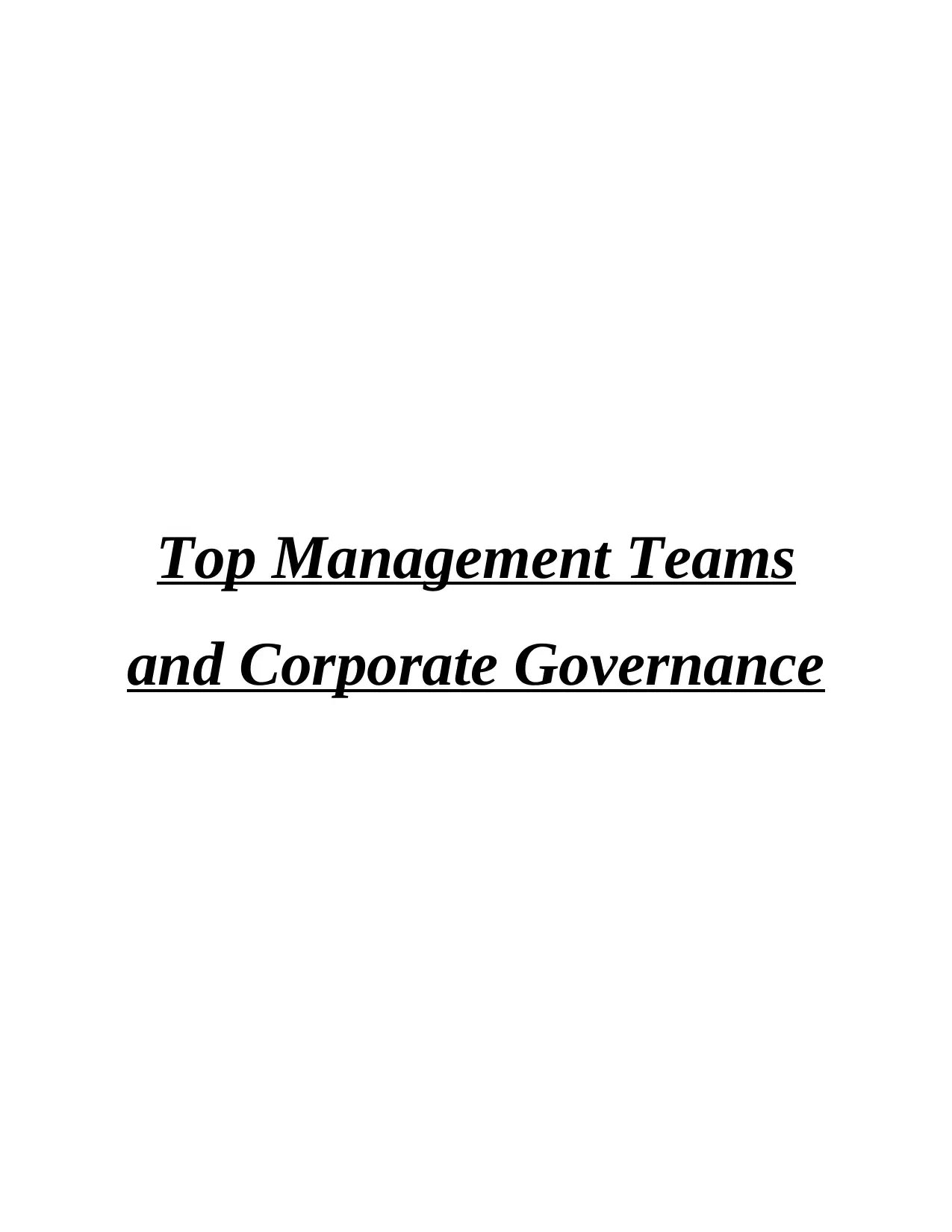
Top Management Teams
and Corporate Governance
and Corporate Governance
Paraphrase This Document
Need a fresh take? Get an instant paraphrase of this document with our AI Paraphraser

Table of Contents
INTRODUCTION...........................................................................................................................1
TASK 1 ..........................................................................................................................................1
CONCLUSION ...............................................................................................................................5
REFERENCES................................................................................................................................7
.........................................................................................................................................................8
INTRODUCTION...........................................................................................................................1
TASK 1 ..........................................................................................................................................1
CONCLUSION ...............................................................................................................................5
REFERENCES................................................................................................................................7
.........................................................................................................................................................8

INTRODUCTION
According to the views of..... strategic decision making is process by which management
develops vision and mission of the firm and takes decision about the future actions which the
company should follow in order to achieve goals and objectives of the firm. Benefits of strategic
planning and how it is helpful in increasing the performance of the firm is also defined. The link
between strategic leader and performance of firm is also described in this report. Apart from this,
difference between leader and strategic leader is defined in the assignment (Hackman,and
Johnson, 2013). At last, different leadership styles and approaches and the issues face by the
management are stated in the present report.
TASK 1
Strategic decision making is a process in which the management creates organisation's
objectives and missions and takes decision about the future course of actions which the company
should follow in order to accomplish those goals and objectives. It is a continuous process in
which strategies are created so that the expected targets can be achieved and revise those
strategies if required, on the basis of outcomes.
Strategic decisions are taken by the management for long term such as, for 5 years or 10
years. These decisions are acknowledged where future planning is required. As per the vision
and mission of the organisation, these decisions are taken. Strategies are made and the overall
planning is done in it so that the goals can be attained.
Strategic planning provides a clear framework and specified directions to the
management that helps them in taking decision (Tschannen-Moran, 2014). Planning creates a
homogeneous purpose and vision which is shared between all the staff members of the firm and
assist them to pull in the similar direction. High commitment is required to achieve the targets of
the firm and strategic decisions helps in it. It administers the way by which the firm can achieve
its targeted goals and objectives. Planning results in improvement in service quality which the
firm offers to its clients. It helps the organisation in setting priorities & matching the firm's
resources to the opportunities. Through strategic decision making, the firm is able to deal with
uncertainties from exterior environment and help in taking competitive advantage from the
market. It enhance the decision making ability of the managers in different fields such as
training, human resource, finance departments etc.
1
According to the views of..... strategic decision making is process by which management
develops vision and mission of the firm and takes decision about the future actions which the
company should follow in order to achieve goals and objectives of the firm. Benefits of strategic
planning and how it is helpful in increasing the performance of the firm is also defined. The link
between strategic leader and performance of firm is also described in this report. Apart from this,
difference between leader and strategic leader is defined in the assignment (Hackman,and
Johnson, 2013). At last, different leadership styles and approaches and the issues face by the
management are stated in the present report.
TASK 1
Strategic decision making is a process in which the management creates organisation's
objectives and missions and takes decision about the future course of actions which the company
should follow in order to accomplish those goals and objectives. It is a continuous process in
which strategies are created so that the expected targets can be achieved and revise those
strategies if required, on the basis of outcomes.
Strategic decisions are taken by the management for long term such as, for 5 years or 10
years. These decisions are acknowledged where future planning is required. As per the vision
and mission of the organisation, these decisions are taken. Strategies are made and the overall
planning is done in it so that the goals can be attained.
Strategic planning provides a clear framework and specified directions to the
management that helps them in taking decision (Tschannen-Moran, 2014). Planning creates a
homogeneous purpose and vision which is shared between all the staff members of the firm and
assist them to pull in the similar direction. High commitment is required to achieve the targets of
the firm and strategic decisions helps in it. It administers the way by which the firm can achieve
its targeted goals and objectives. Planning results in improvement in service quality which the
firm offers to its clients. It helps the organisation in setting priorities & matching the firm's
resources to the opportunities. Through strategic decision making, the firm is able to deal with
uncertainties from exterior environment and help in taking competitive advantage from the
market. It enhance the decision making ability of the managers in different fields such as
training, human resource, finance departments etc.
1
⊘ This is a preview!⊘
Do you want full access?
Subscribe today to unlock all pages.

Trusted by 1+ million students worldwide

Impacts of strategic decision making on organisation-
Provides direction : It clearly determines the purpose of the firm and creates real
objectives and goals persistent with vision and mission that can be precisely communicated. It
administers a base by the help of which growth can be measured and set boundaries so that
effective decisions can be taken.
Increased market share and profitability : Strategic and focused planning helps in
increasing the profitability of the firm. Targeted techniques to opportunities and market that
provides direction to marketing efforts, business decisions, distribution and sales which
ultimately leads the firm to higher profitability and strong market position.
Increases operational efficiency : Strategic planning administers guideline to the
management to align functional activities so that targeted goals can be achieved. It provides
direction to the decision making of administration in identifying budget and resource
requirements to achieve targeted goals.
Allows the firm to being proactive instead of reactive : Planning allows to forecast future &
prepare according to that. By strategic decision making, firm is able to anticipate uncertainties
and take necessary actions to avoid them. Being proactive allows firm to continue with the
dynamic market trends and stay competitive.
So, strategic decision making highly contributes in increasing the performance of the
firm. It plays a vital role in the growth and success of the organisation by providing clear
framework and directions to achieve set goals and objectives of the firm.
Role of strategic leader in firm's performance -
Strategic leaders are those who influence others and encourage them to make decisions
voluntarily that increase the chance of success of the organisation for long term (Avolio, 2010).
They communicate the vision and missions of the organisation to the employees and motivate
and inspire them to achieve the goals and objectives of the firm.
Organisational performance refers to an analysis of the performance of firm against its
goals and objectives. It is the concept in which actual outputs of the company is measured
against standard output.
A strategic leader, by his leadership skills, enhances the performance of the organisation.
He has the ability to cope up with the changes that takes place in the external environment and
formulate such strategies that leads the firm towards growth and sustainability. He has the ability
2
Provides direction : It clearly determines the purpose of the firm and creates real
objectives and goals persistent with vision and mission that can be precisely communicated. It
administers a base by the help of which growth can be measured and set boundaries so that
effective decisions can be taken.
Increased market share and profitability : Strategic and focused planning helps in
increasing the profitability of the firm. Targeted techniques to opportunities and market that
provides direction to marketing efforts, business decisions, distribution and sales which
ultimately leads the firm to higher profitability and strong market position.
Increases operational efficiency : Strategic planning administers guideline to the
management to align functional activities so that targeted goals can be achieved. It provides
direction to the decision making of administration in identifying budget and resource
requirements to achieve targeted goals.
Allows the firm to being proactive instead of reactive : Planning allows to forecast future &
prepare according to that. By strategic decision making, firm is able to anticipate uncertainties
and take necessary actions to avoid them. Being proactive allows firm to continue with the
dynamic market trends and stay competitive.
So, strategic decision making highly contributes in increasing the performance of the
firm. It plays a vital role in the growth and success of the organisation by providing clear
framework and directions to achieve set goals and objectives of the firm.
Role of strategic leader in firm's performance -
Strategic leaders are those who influence others and encourage them to make decisions
voluntarily that increase the chance of success of the organisation for long term (Avolio, 2010).
They communicate the vision and missions of the organisation to the employees and motivate
and inspire them to achieve the goals and objectives of the firm.
Organisational performance refers to an analysis of the performance of firm against its
goals and objectives. It is the concept in which actual outputs of the company is measured
against standard output.
A strategic leader, by his leadership skills, enhances the performance of the organisation.
He has the ability to cope up with the changes that takes place in the external environment and
formulate such strategies that leads the firm towards growth and sustainability. He has the ability
2
Paraphrase This Document
Need a fresh take? Get an instant paraphrase of this document with our AI Paraphraser
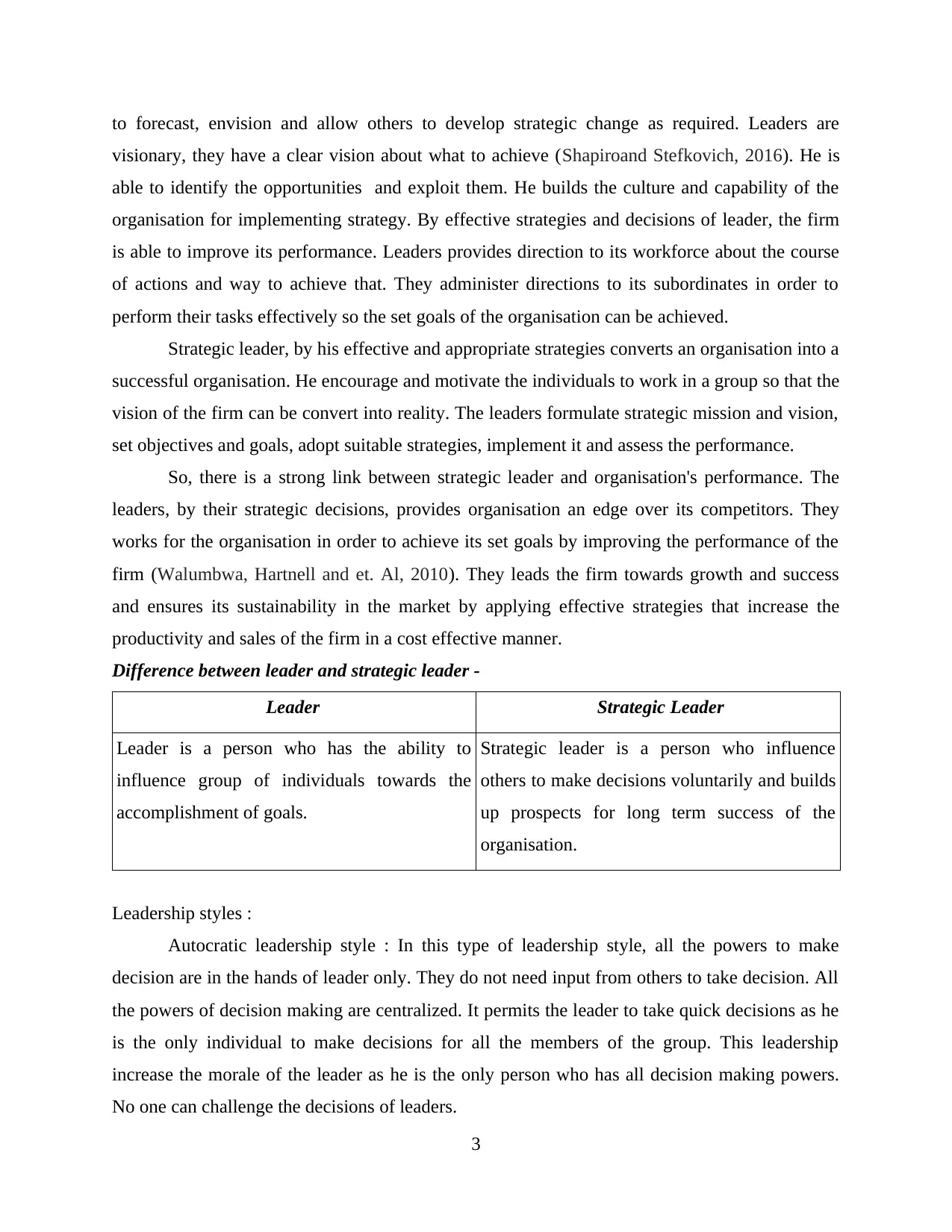
to forecast, envision and allow others to develop strategic change as required. Leaders are
visionary, they have a clear vision about what to achieve (Shapiroand Stefkovich, 2016). He is
able to identify the opportunities and exploit them. He builds the culture and capability of the
organisation for implementing strategy. By effective strategies and decisions of leader, the firm
is able to improve its performance. Leaders provides direction to its workforce about the course
of actions and way to achieve that. They administer directions to its subordinates in order to
perform their tasks effectively so the set goals of the organisation can be achieved.
Strategic leader, by his effective and appropriate strategies converts an organisation into a
successful organisation. He encourage and motivate the individuals to work in a group so that the
vision of the firm can be convert into reality. The leaders formulate strategic mission and vision,
set objectives and goals, adopt suitable strategies, implement it and assess the performance.
So, there is a strong link between strategic leader and organisation's performance. The
leaders, by their strategic decisions, provides organisation an edge over its competitors. They
works for the organisation in order to achieve its set goals by improving the performance of the
firm (Walumbwa, Hartnell and et. Al, 2010). They leads the firm towards growth and success
and ensures its sustainability in the market by applying effective strategies that increase the
productivity and sales of the firm in a cost effective manner.
Difference between leader and strategic leader -
Leader Strategic Leader
Leader is a person who has the ability to
influence group of individuals towards the
accomplishment of goals.
Strategic leader is a person who influence
others to make decisions voluntarily and builds
up prospects for long term success of the
organisation.
Leadership styles :
Autocratic leadership style : In this type of leadership style, all the powers to make
decision are in the hands of leader only. They do not need input from others to take decision. All
the powers of decision making are centralized. It permits the leader to take quick decisions as he
is the only individual to make decisions for all the members of the group. This leadership
increase the morale of the leader as he is the only person who has all decision making powers.
No one can challenge the decisions of leaders.
3
visionary, they have a clear vision about what to achieve (Shapiroand Stefkovich, 2016). He is
able to identify the opportunities and exploit them. He builds the culture and capability of the
organisation for implementing strategy. By effective strategies and decisions of leader, the firm
is able to improve its performance. Leaders provides direction to its workforce about the course
of actions and way to achieve that. They administer directions to its subordinates in order to
perform their tasks effectively so the set goals of the organisation can be achieved.
Strategic leader, by his effective and appropriate strategies converts an organisation into a
successful organisation. He encourage and motivate the individuals to work in a group so that the
vision of the firm can be convert into reality. The leaders formulate strategic mission and vision,
set objectives and goals, adopt suitable strategies, implement it and assess the performance.
So, there is a strong link between strategic leader and organisation's performance. The
leaders, by their strategic decisions, provides organisation an edge over its competitors. They
works for the organisation in order to achieve its set goals by improving the performance of the
firm (Walumbwa, Hartnell and et. Al, 2010). They leads the firm towards growth and success
and ensures its sustainability in the market by applying effective strategies that increase the
productivity and sales of the firm in a cost effective manner.
Difference between leader and strategic leader -
Leader Strategic Leader
Leader is a person who has the ability to
influence group of individuals towards the
accomplishment of goals.
Strategic leader is a person who influence
others to make decisions voluntarily and builds
up prospects for long term success of the
organisation.
Leadership styles :
Autocratic leadership style : In this type of leadership style, all the powers to make
decision are in the hands of leader only. They do not need input from others to take decision. All
the powers of decision making are centralized. It permits the leader to take quick decisions as he
is the only individual to make decisions for all the members of the group. This leadership
increase the morale of the leader as he is the only person who has all decision making powers.
No one can challenge the decisions of leaders.
3
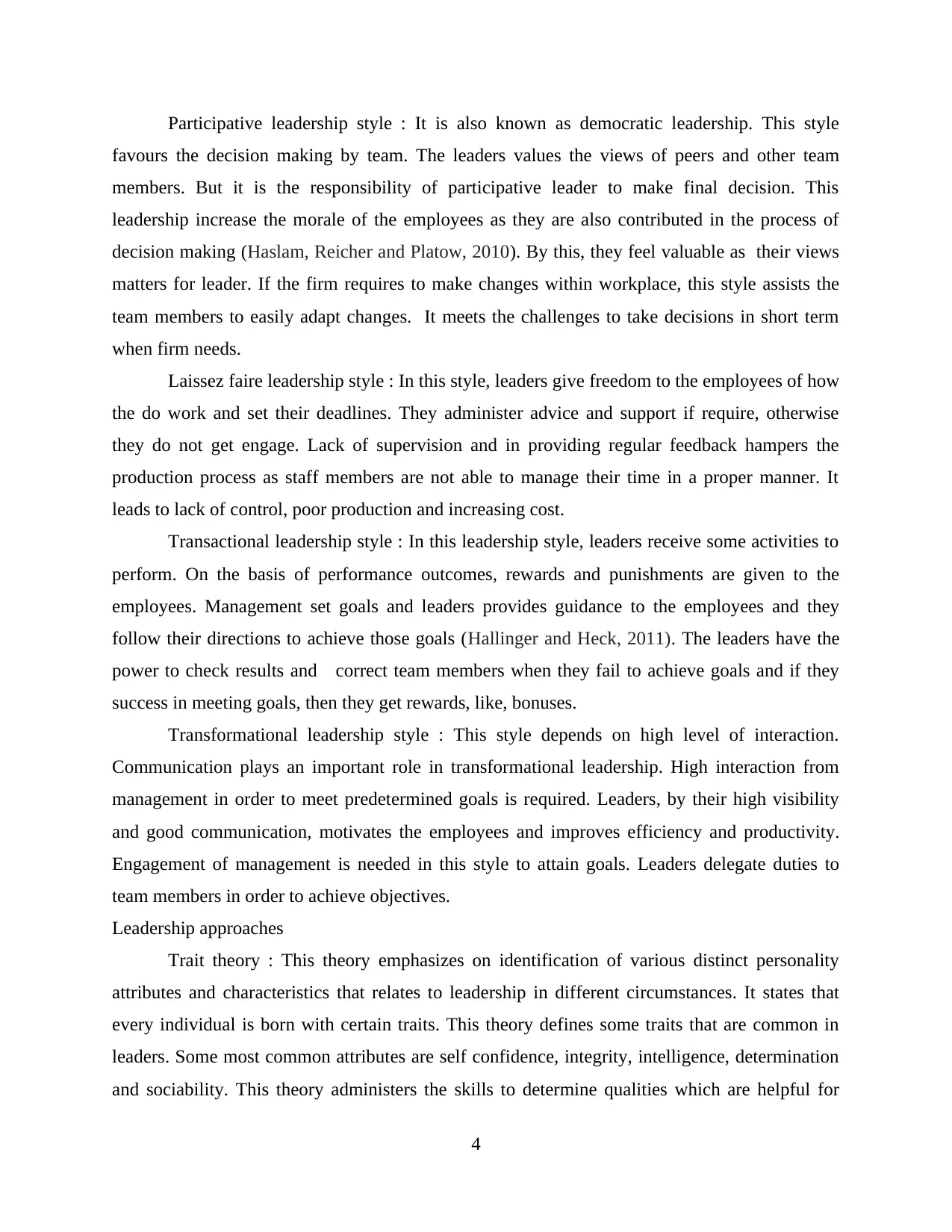
Participative leadership style : It is also known as democratic leadership. This style
favours the decision making by team. The leaders values the views of peers and other team
members. But it is the responsibility of participative leader to make final decision. This
leadership increase the morale of the employees as they are also contributed in the process of
decision making (Haslam, Reicher and Platow, 2010). By this, they feel valuable as their views
matters for leader. If the firm requires to make changes within workplace, this style assists the
team members to easily adapt changes. It meets the challenges to take decisions in short term
when firm needs.
Laissez faire leadership style : In this style, leaders give freedom to the employees of how
the do work and set their deadlines. They administer advice and support if require, otherwise
they do not get engage. Lack of supervision and in providing regular feedback hampers the
production process as staff members are not able to manage their time in a proper manner. It
leads to lack of control, poor production and increasing cost.
Transactional leadership style : In this leadership style, leaders receive some activities to
perform. On the basis of performance outcomes, rewards and punishments are given to the
employees. Management set goals and leaders provides guidance to the employees and they
follow their directions to achieve those goals (Hallinger and Heck, 2011). The leaders have the
power to check results and correct team members when they fail to achieve goals and if they
success in meeting goals, then they get rewards, like, bonuses.
Transformational leadership style : This style depends on high level of interaction.
Communication plays an important role in transformational leadership. High interaction from
management in order to meet predetermined goals is required. Leaders, by their high visibility
and good communication, motivates the employees and improves efficiency and productivity.
Engagement of management is needed in this style to attain goals. Leaders delegate duties to
team members in order to achieve objectives.
Leadership approaches
Trait theory : This theory emphasizes on identification of various distinct personality
attributes and characteristics that relates to leadership in different circumstances. It states that
every individual is born with certain traits. This theory defines some traits that are common in
leaders. Some most common attributes are self confidence, integrity, intelligence, determination
and sociability. This theory administers the skills to determine qualities which are helpful for
4
favours the decision making by team. The leaders values the views of peers and other team
members. But it is the responsibility of participative leader to make final decision. This
leadership increase the morale of the employees as they are also contributed in the process of
decision making (Haslam, Reicher and Platow, 2010). By this, they feel valuable as their views
matters for leader. If the firm requires to make changes within workplace, this style assists the
team members to easily adapt changes. It meets the challenges to take decisions in short term
when firm needs.
Laissez faire leadership style : In this style, leaders give freedom to the employees of how
the do work and set their deadlines. They administer advice and support if require, otherwise
they do not get engage. Lack of supervision and in providing regular feedback hampers the
production process as staff members are not able to manage their time in a proper manner. It
leads to lack of control, poor production and increasing cost.
Transactional leadership style : In this leadership style, leaders receive some activities to
perform. On the basis of performance outcomes, rewards and punishments are given to the
employees. Management set goals and leaders provides guidance to the employees and they
follow their directions to achieve those goals (Hallinger and Heck, 2011). The leaders have the
power to check results and correct team members when they fail to achieve goals and if they
success in meeting goals, then they get rewards, like, bonuses.
Transformational leadership style : This style depends on high level of interaction.
Communication plays an important role in transformational leadership. High interaction from
management in order to meet predetermined goals is required. Leaders, by their high visibility
and good communication, motivates the employees and improves efficiency and productivity.
Engagement of management is needed in this style to attain goals. Leaders delegate duties to
team members in order to achieve objectives.
Leadership approaches
Trait theory : This theory emphasizes on identification of various distinct personality
attributes and characteristics that relates to leadership in different circumstances. It states that
every individual is born with certain traits. This theory defines some traits that are common in
leaders. Some most common attributes are self confidence, integrity, intelligence, determination
and sociability. This theory administers the skills to determine qualities which are helpful for
4
⊘ This is a preview!⊘
Do you want full access?
Subscribe today to unlock all pages.

Trusted by 1+ million students worldwide
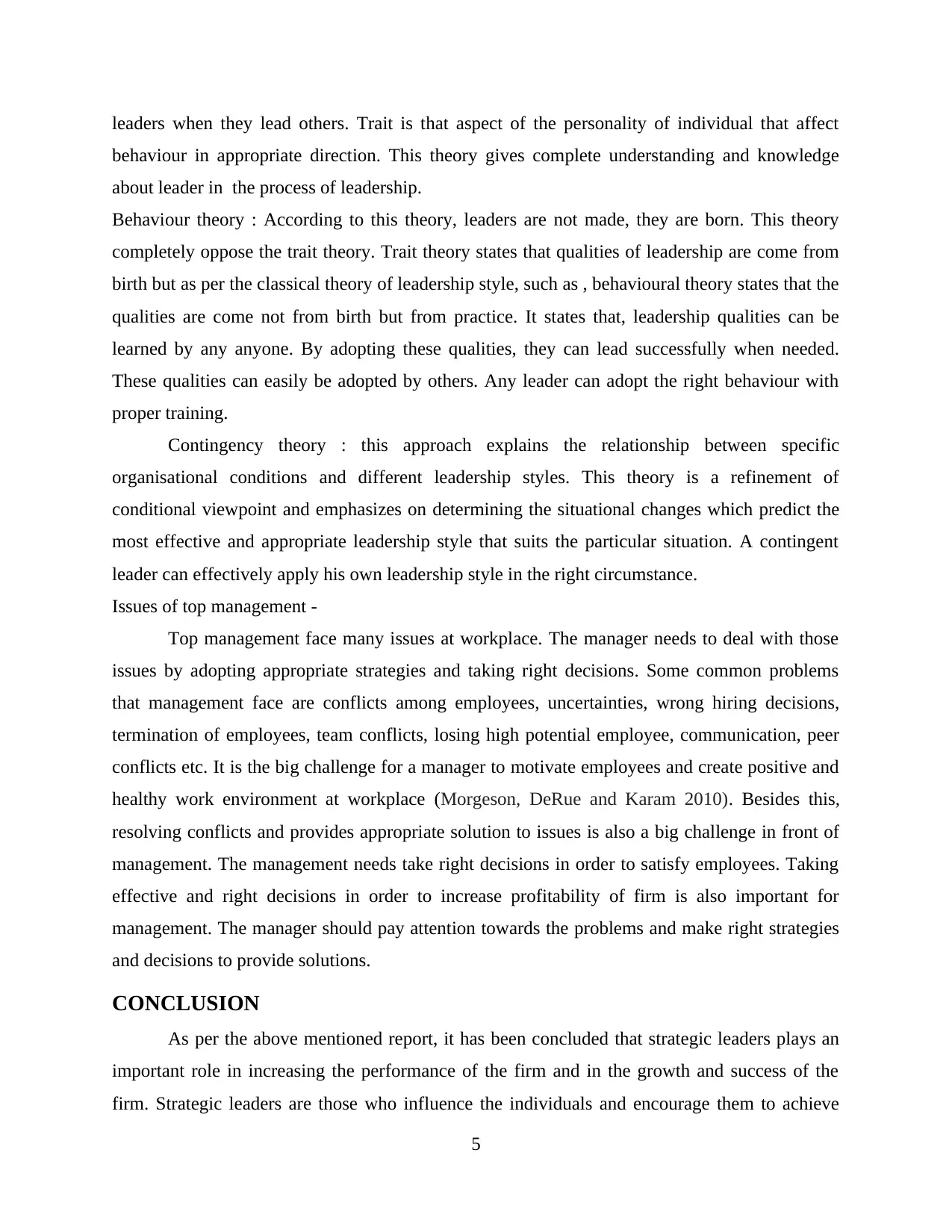
leaders when they lead others. Trait is that aspect of the personality of individual that affect
behaviour in appropriate direction. This theory gives complete understanding and knowledge
about leader in the process of leadership.
Behaviour theory : According to this theory, leaders are not made, they are born. This theory
completely oppose the trait theory. Trait theory states that qualities of leadership are come from
birth but as per the classical theory of leadership style, such as , behavioural theory states that the
qualities are come not from birth but from practice. It states that, leadership qualities can be
learned by any anyone. By adopting these qualities, they can lead successfully when needed.
These qualities can easily be adopted by others. Any leader can adopt the right behaviour with
proper training.
Contingency theory : this approach explains the relationship between specific
organisational conditions and different leadership styles. This theory is a refinement of
conditional viewpoint and emphasizes on determining the situational changes which predict the
most effective and appropriate leadership style that suits the particular situation. A contingent
leader can effectively apply his own leadership style in the right circumstance.
Issues of top management -
Top management face many issues at workplace. The manager needs to deal with those
issues by adopting appropriate strategies and taking right decisions. Some common problems
that management face are conflicts among employees, uncertainties, wrong hiring decisions,
termination of employees, team conflicts, losing high potential employee, communication, peer
conflicts etc. It is the big challenge for a manager to motivate employees and create positive and
healthy work environment at workplace (Morgeson, DeRue and Karam 2010). Besides this,
resolving conflicts and provides appropriate solution to issues is also a big challenge in front of
management. The management needs take right decisions in order to satisfy employees. Taking
effective and right decisions in order to increase profitability of firm is also important for
management. The manager should pay attention towards the problems and make right strategies
and decisions to provide solutions.
CONCLUSION
As per the above mentioned report, it has been concluded that strategic leaders plays an
important role in increasing the performance of the firm and in the growth and success of the
firm. Strategic leaders are those who influence the individuals and encourage them to achieve
5
behaviour in appropriate direction. This theory gives complete understanding and knowledge
about leader in the process of leadership.
Behaviour theory : According to this theory, leaders are not made, they are born. This theory
completely oppose the trait theory. Trait theory states that qualities of leadership are come from
birth but as per the classical theory of leadership style, such as , behavioural theory states that the
qualities are come not from birth but from practice. It states that, leadership qualities can be
learned by any anyone. By adopting these qualities, they can lead successfully when needed.
These qualities can easily be adopted by others. Any leader can adopt the right behaviour with
proper training.
Contingency theory : this approach explains the relationship between specific
organisational conditions and different leadership styles. This theory is a refinement of
conditional viewpoint and emphasizes on determining the situational changes which predict the
most effective and appropriate leadership style that suits the particular situation. A contingent
leader can effectively apply his own leadership style in the right circumstance.
Issues of top management -
Top management face many issues at workplace. The manager needs to deal with those
issues by adopting appropriate strategies and taking right decisions. Some common problems
that management face are conflicts among employees, uncertainties, wrong hiring decisions,
termination of employees, team conflicts, losing high potential employee, communication, peer
conflicts etc. It is the big challenge for a manager to motivate employees and create positive and
healthy work environment at workplace (Morgeson, DeRue and Karam 2010). Besides this,
resolving conflicts and provides appropriate solution to issues is also a big challenge in front of
management. The management needs take right decisions in order to satisfy employees. Taking
effective and right decisions in order to increase profitability of firm is also important for
management. The manager should pay attention towards the problems and make right strategies
and decisions to provide solutions.
CONCLUSION
As per the above mentioned report, it has been concluded that strategic leaders plays an
important role in increasing the performance of the firm and in the growth and success of the
firm. Strategic leaders are those who influence the individuals and encourage them to achieve
5
Paraphrase This Document
Need a fresh take? Get an instant paraphrase of this document with our AI Paraphraser
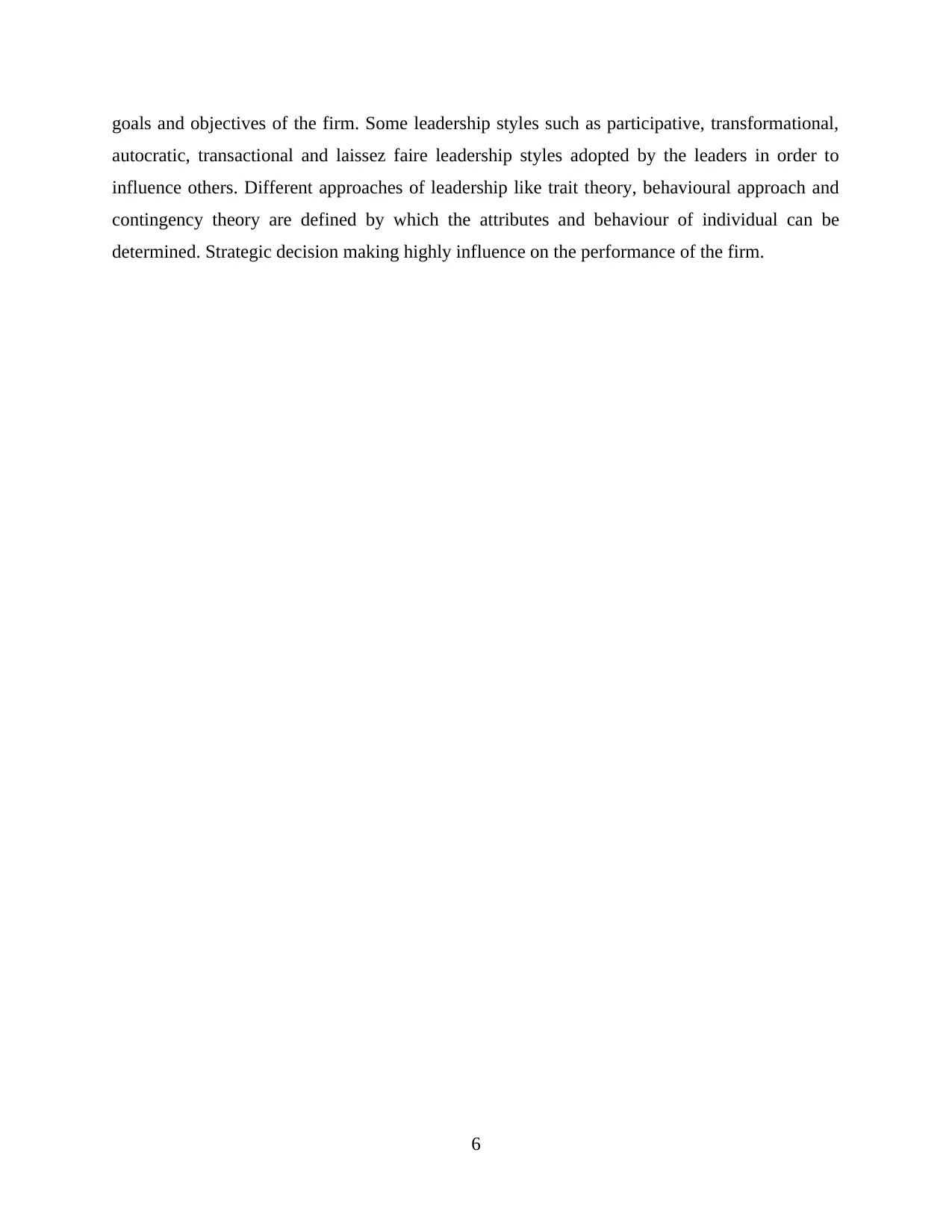
goals and objectives of the firm. Some leadership styles such as participative, transformational,
autocratic, transactional and laissez faire leadership styles adopted by the leaders in order to
influence others. Different approaches of leadership like trait theory, behavioural approach and
contingency theory are defined by which the attributes and behaviour of individual can be
determined. Strategic decision making highly influence on the performance of the firm.
6
autocratic, transactional and laissez faire leadership styles adopted by the leaders in order to
influence others. Different approaches of leadership like trait theory, behavioural approach and
contingency theory are defined by which the attributes and behaviour of individual can be
determined. Strategic decision making highly influence on the performance of the firm.
6

REFERENCES
Books & Journals
Hafford-Letchfield, T. and Bourn, D., 2011. ‘How Am I Doing?’: Advancing Management Skills
Through the Use of a Multi-source Feedback Tool to Enhance Work-based Learning on
a Post-qualifying Post-graduate Leadership and Management Programme. Social Work
Education. 30(5). pp.497-511.
Hallinger, P. and Heck, R. H., 2011. sCollaborative leadership and school improvement:
Understanding the impact on school capacity and student learning. In International
handbook of leadership for learning. pp. 469-485. Springer Netherlands.
NI, Q., Hird, C. C. and Guymer, I., 2010. Physical modelling of pile penetration in clay using
transparent soil and particle image velocimetry. Géotechnique. 60(2). pp.121-132.
Ellis, L. A. and Petersen, A. K., 2011. A way forward: Assessing the demonstrated leadership of
graduate civil engineering and construction management students. Leadership and
Management in Engineering. 11(2). pp.88-96.
Bush, T. and Glover, D., 2014. School leadership models: What do we know?. School
Leadership & Management. 34(5). pp.553-571.
Muijs, D., and et. al., 2010. Leading under pressure: Leadership for social inclusion. School
Leadership and Management. 30(2). pp.143-157.
Dimmock, C. and Goh, J. W., 2011. Transformative pedagogy, leadership and school
organisation for the twenty-first-century knowledge-based economy: The case of
Singapore. School Leadership & Management. 31(3). pp.215-234.
Dawson, M., Burrell, D. N. and Rahim, E., 2010. Deep dive into understanding the theory of
military organization, military leadership, skill transfer, aspects of program
management, and decision support systems. nternational Handbook of Academic
Research and Teaching. p.33.
Kark, R. and Shamir, B., 2013. The dual effect of transformational leadership: Priming relational
and collective selves and further effects on followers. In Transformational and
Charismatic Leadership: The Road Ahead 10th Anniversary Edition. pp. 77-101.
Emerald Group Publishing Limited.
7
Books & Journals
Hafford-Letchfield, T. and Bourn, D., 2011. ‘How Am I Doing?’: Advancing Management Skills
Through the Use of a Multi-source Feedback Tool to Enhance Work-based Learning on
a Post-qualifying Post-graduate Leadership and Management Programme. Social Work
Education. 30(5). pp.497-511.
Hallinger, P. and Heck, R. H., 2011. sCollaborative leadership and school improvement:
Understanding the impact on school capacity and student learning. In International
handbook of leadership for learning. pp. 469-485. Springer Netherlands.
NI, Q., Hird, C. C. and Guymer, I., 2010. Physical modelling of pile penetration in clay using
transparent soil and particle image velocimetry. Géotechnique. 60(2). pp.121-132.
Ellis, L. A. and Petersen, A. K., 2011. A way forward: Assessing the demonstrated leadership of
graduate civil engineering and construction management students. Leadership and
Management in Engineering. 11(2). pp.88-96.
Bush, T. and Glover, D., 2014. School leadership models: What do we know?. School
Leadership & Management. 34(5). pp.553-571.
Muijs, D., and et. al., 2010. Leading under pressure: Leadership for social inclusion. School
Leadership and Management. 30(2). pp.143-157.
Dimmock, C. and Goh, J. W., 2011. Transformative pedagogy, leadership and school
organisation for the twenty-first-century knowledge-based economy: The case of
Singapore. School Leadership & Management. 31(3). pp.215-234.
Dawson, M., Burrell, D. N. and Rahim, E., 2010. Deep dive into understanding the theory of
military organization, military leadership, skill transfer, aspects of program
management, and decision support systems. nternational Handbook of Academic
Research and Teaching. p.33.
Kark, R. and Shamir, B., 2013. The dual effect of transformational leadership: Priming relational
and collective selves and further effects on followers. In Transformational and
Charismatic Leadership: The Road Ahead 10th Anniversary Edition. pp. 77-101.
Emerald Group Publishing Limited.
7
⊘ This is a preview!⊘
Do you want full access?
Subscribe today to unlock all pages.

Trusted by 1+ million students worldwide

8
1 out of 10
Related Documents
Your All-in-One AI-Powered Toolkit for Academic Success.
+13062052269
info@desklib.com
Available 24*7 on WhatsApp / Email
![[object Object]](/_next/static/media/star-bottom.7253800d.svg)
Unlock your academic potential
Copyright © 2020–2025 A2Z Services. All Rights Reserved. Developed and managed by ZUCOL.





